L01 The Science of Genetics
一、Genetics
Introduction
Genetics is the science of genes, heredity, and variation in living organisms.
This discipline involves the study of cells, individuals, their offspring, and the populations within which organisms live
Scientists investigate all form of inherited variation as well as the molecular basis underlying such characteristics.
1. Transmission Genetics/Mendelian Genetics (Classic Genetics) 经典遗传学
Transmission genetics is the oldest field of genetics
- It examines how traits are passed from one generation to the next
The conceptual framework was provided by Gregor Mendel in the 1860s
- Genetic determinants pass from parent to offspring as discrete units
- These are now termed genes
During this time, geneticists pursued their science by analyzing the outcomes of crosses between different strains of organisms, much as Mendel had done in his work with peas.
Genetic Cross 基因杂交
The basic experimental approach is the genetic cross
- Two selected individuals are mated
- The traits in question are analyzed over several generations
- Analysis is often quantitative in nature
2. Molecular Genetics 分子遗传学
Molecular genetics is the most modern field of genetics
- It deals with how the molecular features of DNA underlie gene expression
- Gene organization, function and regulation
- Detailed analysis of DNA, RNA and proteins
- Example: Loss‐of‐function mutation which eliminates the function of a gene, often revealing its role in creating a trait.
The replication, expression, and mutation of genes could now be studied at the molecular level. This approach to genetic analysis was raised to a new level when it became possible to sequence DNA molecules easily.
3. Population Genetics (Classic Genetics) 群体遗传学
Population genetics deals with the genetic variation of populations and how that variation is related to the environment
Population geneticists develop mathematical theories to explain the prevalence(流行,广泛) of certain alleles within populations
Genetics can also be studied at the level of an entire population of organisms. Individuals within a population may carry different alleles of a gene; perhaps they carry different alleles of many genes. These differences make individuals genetically distinct, possibly even unique.
Centrol Dogma
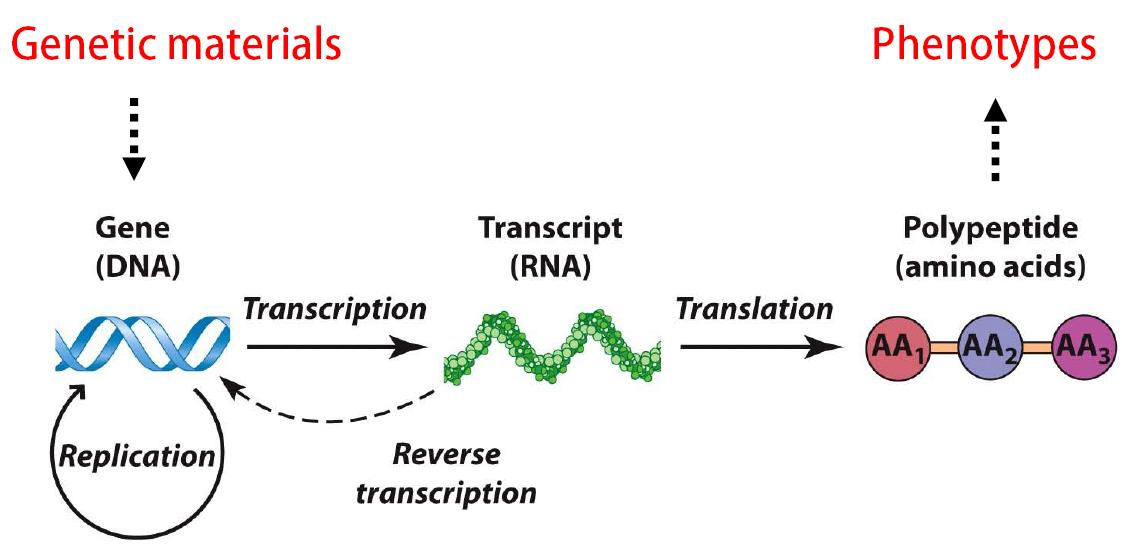
1. Genetic material
In eukaryotes and prokaryotes, DNA (deoxyribonucleic acid) serves as the molecular storing genetic information. In virus, either DNA or RNA (ribonucleic acid) serves this function.
2. Gene
Gene is the functional unit of heredity. It is an informational storage unit capable of undergoing replication, mutation, and expression. In chemical terms, it is a linear array of nucleotides – the chemical building blocks of DNA and RNA.
3. Phenotypes
The observable characteristics or traits of an organism, such as its morphology, development, biochemical or physiological properties, and behavior.
Three Great Milestones in Genetics
- 1866 Gregor Mendel: The discovery of rules governing the inheritance of traits in organisms (Genes and the
rules of inheritance) - 1953 James Watson and Francis Crick: The identification of the material responsible for this inheritance and the elucidation of its structure (structure of DNA)
- 2003 The Human Genome Project: The comprehensive analysis of the hereditary material in human beings and other organisms, (sequencing DNA and cataloguing genes)
二、The Rules of Inheritance
Gregor Mendel
- Studied the inheritance of different traits of peas.
- Discovered that “genes” exits in different forms (now call alleles).
- Proposed pea has 2 copies of each “genes”.
The Rule
Alleles of the same gene separate during gamete formation.
Alleles of different genes are inherited independently.
三、The Structure of DNA
Nucleic acids are made of building blocks called nucleotides.
Nucleotides are linked in a chain through sugar‐phosphate interactions.
Nucleotides
Nucleotides have three components:
- Sugar molecule (ribose or deoxyribose)
- Phosphate molecule
- Nitrogen‐containing molecule : (adenine, guanine, cytosine, thymine, uracil)
RNA is ribonucleic acid.
DNA is deoxyribonucleic acid.
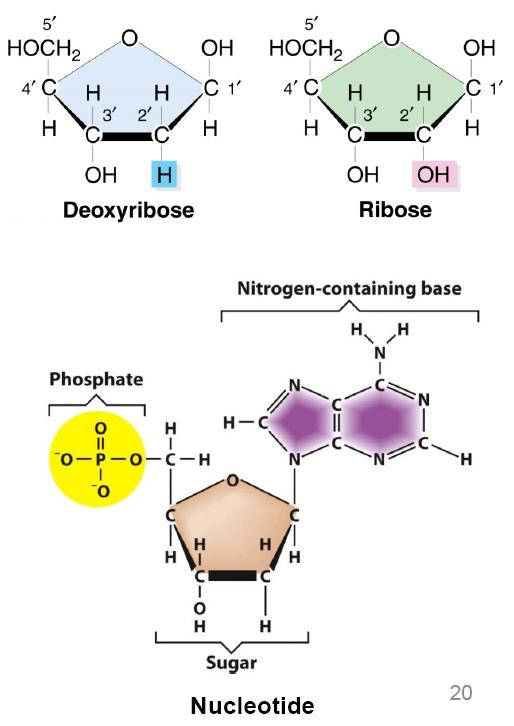
- DNA molecules are made of two chains of nucleotides wound around each other in a helix
- Two chains are held together by hydrogen bonds
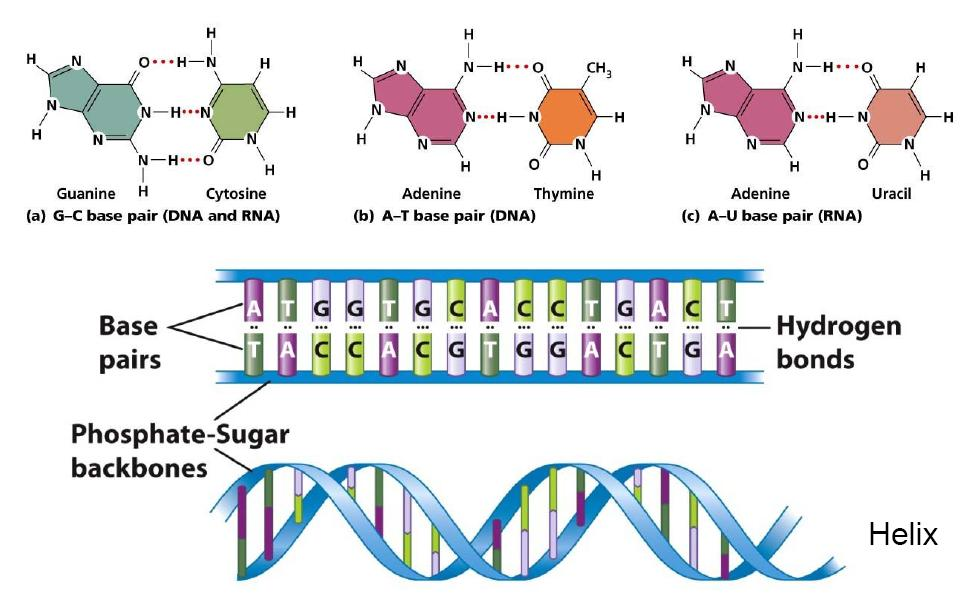
Base Pairs
Base pairs hold the chains together
Adenine (A) pairs with Thymine (T) / Uracil (U)
Guanine (G) pairs with Cytosine (C)
Two chains of a DNA molecule are complementary.
The Human Genome Project
Sequencing DNA and Cataloguing Genes
Genome (基因组)
Genome—the collection of DNA molecules that is characteristic of an organism.
Genomics(基因组学) is the analysis of DNA sequences that make up a genome. Genomics involves DNA sequencing technology, robotics, and computer science.
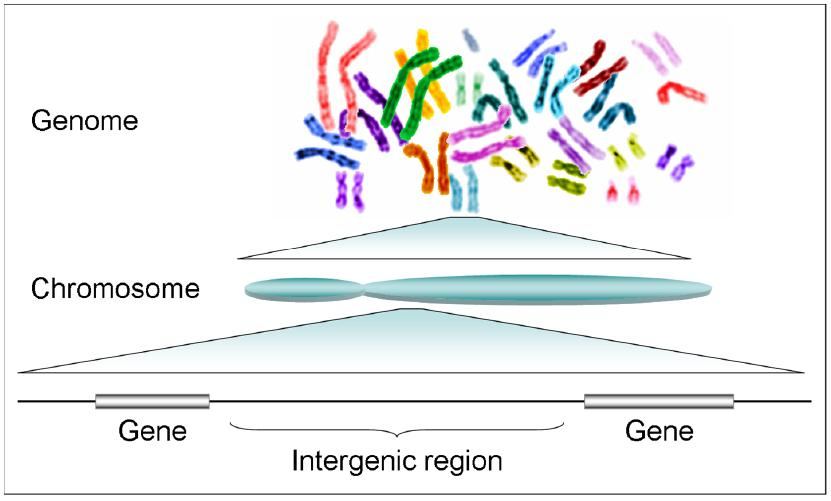
四、Molecular Level of Genetics
DNA as the Genetic Material
- Information flows from DNA to RNA to protein.
- In all cellular organisms, the genetic material is DNA.
The genetic material
Must be able to replicate
Must contain information
Must be able to change
DNA Replication
Based on the complementary nature of the two strands of duplex DNA molecules.
When the two parental strands are separated, the separated strands can serve as template for the synthesis of new strands.
New strands are assembled by incorporating nucleotides according to base‐pairing rules.
At the end of replication, each template strand is paired with a newly synthesized partner strand.
DNA replication is catalyzed by enzymes.
Gene Expression
During transcription, an RNA molecule (mRNA) is synthesized from a DNA template.
messenger RNA (mRNA) molecules contains the information needed to synthesize a polypeptide.
During translation, the triplet codons in the RNA specify the incorporation of particular amino acids into a polypeptide chain.

Trait And Genes
1. Trait
A trait is any characteristic that an organism displays
Morphological traits 形态学特征
Affect the appearance of the organism
Example: The color of a flower
Physiological traits 生理学特征
Affect the function of the organism
Example: Ability to metabolize a sugar
Behavioral traits 行为学特征
Affect the ways an organism responds to the environment
Example: Mating calls of bird species
2. Relationship Between Traits And Genes
- Genes/traits within a particular species can be studied at the population level
- Traits are observed at the organism level
- Proteins function at the cellular level
- Genes are expressed at the molecular level
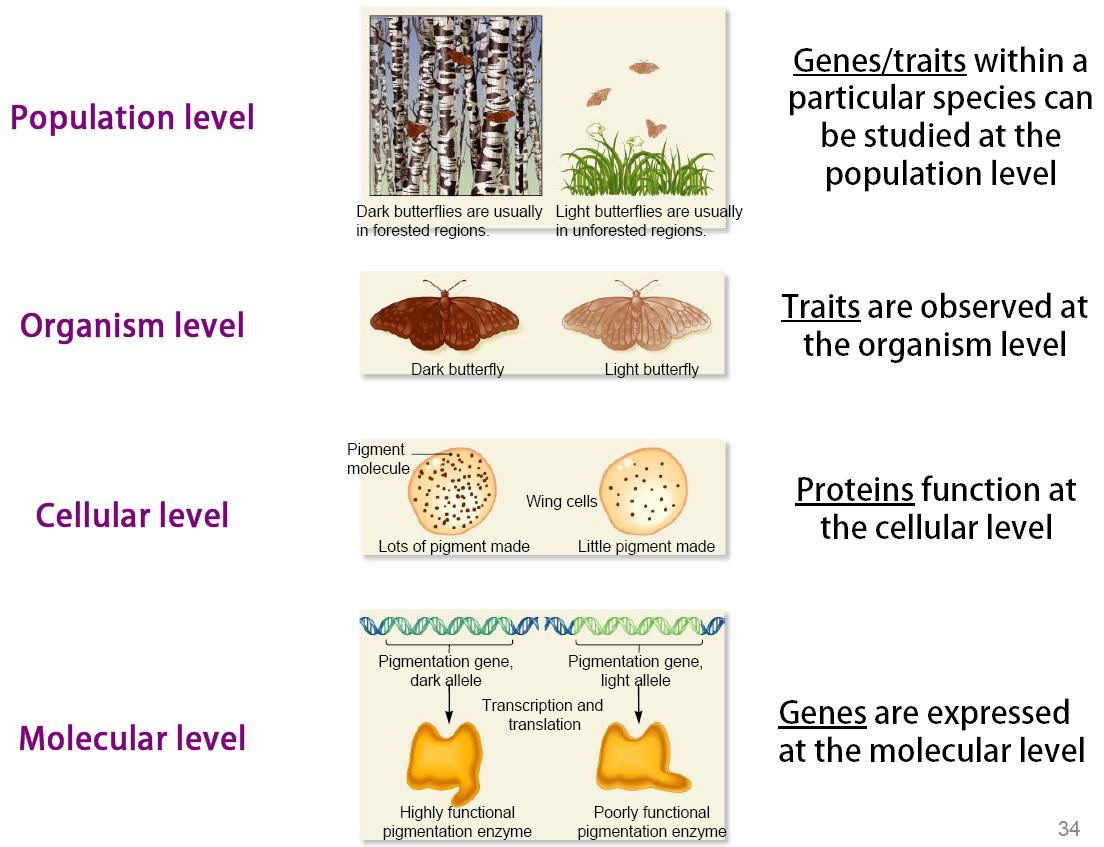
3. Influence Factor of Traits
The traits an individual expresses do not result from its genes alone.
Rather, traits are a result of the interaction between genes and the environment.
- For example, an individual’s diet has an effect on his/her height and weight and even intelligence
- In some cases, the environment dictates whether a disease is manifested in an individual or not. (在某些情况下,环境决定了一种疾病是否表现在一个人身上。)
Phenylketonuria (PKU,苯丙酮尿症)
Humans have a gene encoding the enzyme phenylalanine hydroxylase (苯丙氨酸羟化酶)
Humans with one or two functional copies of this gene can metabolize phenylalanine
Humans with two copies of a rare inactive allele cannot metabolize phenylalanine

Phenylalanine will thus accumulate
- It ultimately causes a number of detrimental effects; Mental impairment
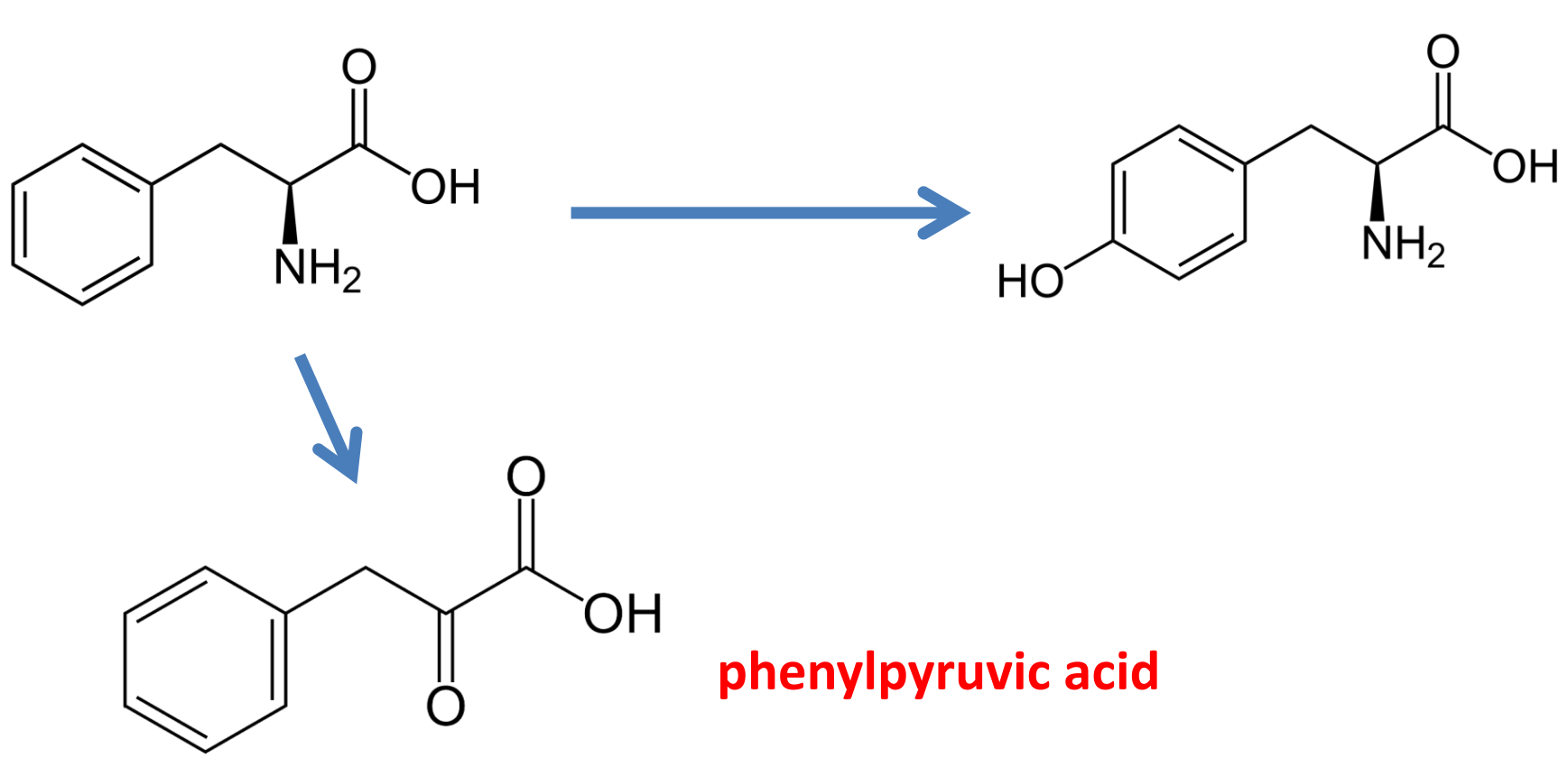
Newborns are now routinely screened for PKU
Individuals with the disease are put on a strict dietary regimen Their diet is essentially phenylalanine‐free
These individuals tend to develop normally
五、Inheritance
Inherited Differences in Traits Are Due to Genetic Variation
Genetic variation is a result of various types of changes to DNA at the molecular level.
1. Gene mutations
- Differences in gene sequences
Lead to two or more expression forms or alleles of the same gene
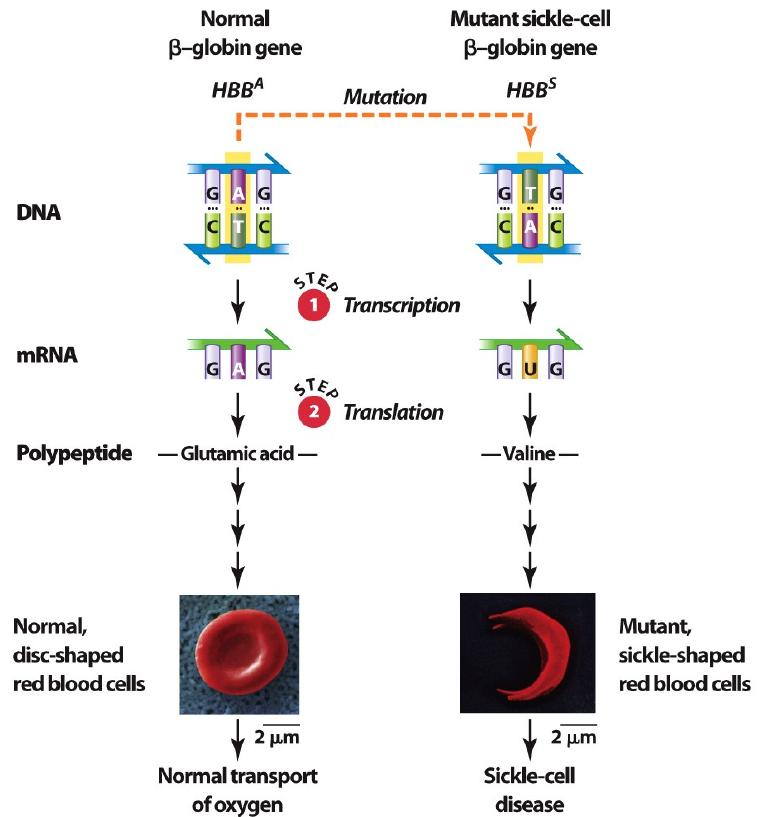
2. Changes in chromosome structure
- Large segments of a chromosome may be lost, duplicated or reattached to another chromosome
3. Changes in chromosome number
- Single chromosomes may be lost or gained
A whole extra set of chromosomes may be inherited
Natural Selection
Natural selection can be summarized as such:
Members of a species compete for essential resources.
In some individuals, random mutations lead to beneficial alleles.
Individuals are better adapted to the environment
These individuals are more likely to survive and reproduce
Therefore, the beneficial alleles are passed on to subsequent generations
Thus, genetic changes can accumulate.
These can slowly lead to remarkable modifications in the characteristics of a species